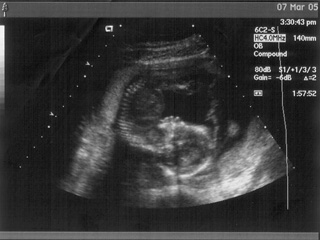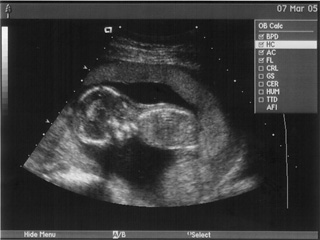Today, we went to a perinatology center to have a detailed ultrasound and amniocentesis. A perinatologist is someone who specializes in maternal-fetal health and often deals with complicated or relatively risky pregnancies. The perinatologist, however, managed to convince us not to have the amnio. It turns out that having a prior molar pregnancy doesn’t really increase the risk of having a baby with genetic abnormalities–it just increases the risk of having another molar pregnancy, which we know we don’t have. Also, it turns out that although the risk of fetal death from amniocentesis is 1 in 200 for a single fetus, the risk is actually 1 in 50 for twins, which was higher than we expected. That statistic was enough to scare us from having the amnio done.
Since we’re not having the amnio done now, we’re going to go back to the “triple screen” exam to screen for any complications. The triple screen measures the levels of certain chemicals that are produced by the fetus and end up in the mother’s blood stream. Levels that are too high or two low can both indicate that there is a problem. Because there are two fetuses, the results are less certain. There’s a higher chance for false positives (bad results when everything is actually normal) and false negatives (normal results when something is actually bad), but it still tells us enough to decide if it is worth taking the 1 in 50 risk on the twin amniocentesis.
The exciting part of the visit was the ultrasound, which was much more detailed than the cursory ultrasounds that are performed at my routine OB appointments. They measured the head, the arms, the legs, the abdomen, and the cerebellum. And this was for two fetuses, so it took a while. Then, they tried to figure out the sex of the twins. We posted pictures of the two fetuses below. The one in the first picture is completely curled up, with its feet up by its head, so they had a really hard time visualizing the groin area. The one in the second picture is lying flatter (although its legs are out of view of the picture), but they were pretty sure that one is a girl. They then tried to determine whether they are fraternal or identical twins. Apparently, there are a few membrane characteristics that point more towards identical twins, as opposed to fraternal twins. Because the membrane is relatively thin and it attaches to the wall in a “T” formation, as opposed to a “lambda” formation (the “twin peak” sign), it’s more likely that we’re having identical twins! In fact, the perinatologist said “eighty percent chance that they’re identical twin girls”.





Twin girls!!! 8:) 8:)
They are going to be so cute!!!